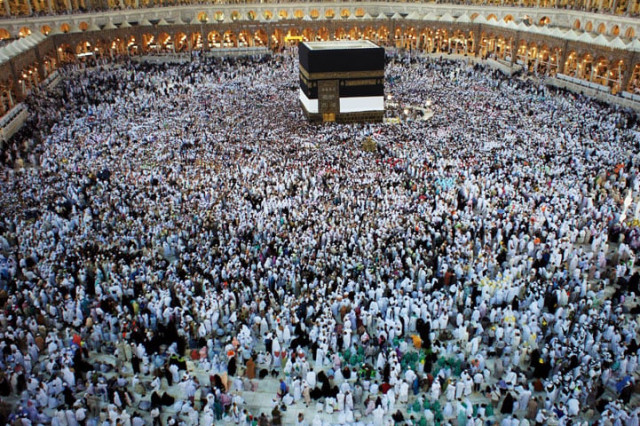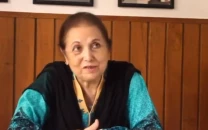Road to Makkah: The cost of visiting the house of God
Difference in services provided by govt and private schemes spark debate over commercialization of Hajj

Muslim pilgrims perform Tawaf at the Grand Masjid (Mosque) in the Saudi holy city of Makkah early morning on November 9, 2010. PHOTO: AFP
“The idea was to increase options for pilgrims,” says Hajj Organisers Association of Pakistan (HOAP) Chairperson Muhammad Nadeem Sharif. The private scheme is managed by tour operators registered with the ministry and are identified as Hajj Group Organisers (HGOs). Currently, around 750 HGOs are registered with the government while many more are likely to be added this year.
Private packages and their pitfalls
Initially, private tour operators were given only 30,000 to 60,000 pilgrims from the total number allowed to perform Hajj in a year, says Sharif. But the number was later equally divided between the government and private sector. “I believe that gradually the entire management of the holy journey will be privatised,” states Sharif.
 A pilgrim reads from a copy of the Quran as he prays on top of Mount Arafat, near the holy city of Makkah, ahead of the hajj main ritual, on October 14, 2013. PHOTO: AFP
A pilgrim reads from a copy of the Quran as he prays on top of Mount Arafat, near the holy city of Makkah, ahead of the hajj main ritual, on October 14, 2013. PHOTO: AFPDetails of all authorised HGOs are available on the ministry’s website and with Haji camps across the country, says Ministry of Religious Affairs (MORA) Joint Secretary Noor Zaman. However, he feels not many people use the website for finding registered HGOs and, instead, rely on friends and family for recommendation. “HGOs run their business mostly through word of mouth,” says Zaman.
Plea against alleged anti-Shia bias
The distribution of pilgrims among registered HGOs is done through a ‘matrix of categorisation’ which considers performance indicators such as volume of business managed since the introduction of the private Hajj scheme and number of Hajj operations undertaken by each HGO. “As per the rules, the maximum number of pilgrims that can be allocated to one HGO is 600,” informs Sharif. But each year new HGOs enter the market and some are blacklisted so the number of pilgrims is reallocated between them, adds the HOAP chief.
To increase competition and improve service, the government has registered around 2,000 new tour companies this year. “Their performance and abilities have been assessed and the ministry will assign them pilgrims based on their scores,” MORA’s Zaman explains. Skeptical of the process, Sharif says the government didn’t set a passing score and everyone who applied was registered.
Saudi says Iranian pilgrims welcome despite rift
The modus operandi of all these registered HGOs is the same; pilgrims approach an HGO and pick out a Hajj package for themselves. In some instances, however, HGOs use middlemen to attract customers, which is forbidden in the service agreement signed between the government and HGOs. According to Zaman, it is common practice to take help from agents and share profits with them. “This is done informally but is prevalent,” says Zaman, adding that authorised HGOs are legally bound to deal with pilgrims directly.
Sharif, however, has a different opinion on this. “When the government allows multiple HGOs to collaborate in arranging a Hajj tour, what’s wrong in using and paying subagents to facilitate pilgrims?” he asks. He, however, agrees that all dealings should be undertaken at an HGO’s office in person. “Both parties should know what they are agreeing to and there should be no confusion,” he stresses.
 A pilgrim prays at the Mount of Mercy (Jabal al-Rahma) in the plain of Arafat, southeast of the holy city of Makkah, on November 21, 2009. PHOTO: AFP
A pilgrim prays at the Mount of Mercy (Jabal al-Rahma) in the plain of Arafat, southeast of the holy city of Makkah, on November 21, 2009. PHOTO: AFPThe private Hajj scheme has been criticised on several occasions for commericalising the holy pilgrimage, but tour operators insist the exorbitant price tag is backed by a valid reason. HOAP’s Sharif says private Hajj packages range between Rs0.35 million and Rs1.5 million, depending on the pilgrim’s demands. “Less than 2% of total pilgrims opting for the private scheme purchase high-end packages, 60% take less-expensive packages and the rest go for mid-range options,” he says.
Explaining why even the cheapest private package is higher than what the government offers, Sharif says the ministry has the state machinery at its disposal which excludes the cost of staff salaries, income tax and other utilities from their packages. “All in all, there’s at least a difference of Rs80,000 on the costs incurred by private operators in comparison to the government,” he claims. Therefore, it is only understandable why private packages are more expensive, he adds.
Muslim man jailed for selling fake Hajj trips in UK
To rein in the capitalist drive, Zaman says the government is considering putting a cap on the prices of Hajj packages this year. “The current system doesn’t have a limit on how expensive a package can be but now there is a view that there should be a ceiling,” Zaman says, adding that for this purpose the government has asked all HGOs to share their suggestions.
Giving details of the extent to which government and private schemes vary, the HOAP chief says that while the government accommodates pilgrims away from Masjid al-Haram, private tour operators book hotels close to the holy mosque. “Our pilgrims have tents in the inner part of Mina while government pilgrims stay on the periphery of the neighbourhood. We offer a buffet to our customers against the government’s one dish per meal served in polythene bags. For a Rs1.5 million package, we book peak season flights and five-star hotels,” Sharif lists. “Sometimes we are asked to reserve a tent which can accommodate eight people for only two pilgrims. Who will pay for the loss incurred? The customer, not me,” he adds.
The MORA official understands the dynamics of the private scheme and agrees with Sharif. “Tour organisers charge for all the facilities they provide to pilgrims on their demand. Everyone prefers to stay closer to the Haram and the cost increases by a big margin if the hotel is located in the vicinity. If you ask me, I would also choose to pay more and be closer to the Kaaba,” admits Zaman.
Checks and balances
To make sure pilgrims complete their holy journey in peace, Zaman says the government sends a monitoring team to Saudi Arabia during Hajj to interview pilgrims about each HGO’s performance and help them if needed. The Hajjis, Zaman says, are given helpline numbers where they can register complaints. “If a pilgrim tells us they were not placed in a hotel they were promised and given proper food or faced transportation-related problems, the government’s monitoring team immediately meets with the head of the HGO and seeks relief for the pilgrim,” he says.
 Pakistani hajj pilgrims queue to check-in at Karachi airport for the first hajj flight to Saudi Arabia on late August 15, 2015. PHOTO: AFP
Pakistani hajj pilgrims queue to check-in at Karachi airport for the first hajj flight to Saudi Arabia on late August 15, 2015. PHOTO: AFPIf the HGO fails to satisfy the pilgrim, a complaint is registered against it, explains Zaman. “Once the Hajj season is over, the complaint is reviewed by the ministry and a hearing is held. If the HGO doesn’t give a satisfactory explanation, it is either fined, banned for a certain period or has its quota reduced,” he states. But HOAP’s Sharif is critical of the government’s redress scheme and claims he knows people who had their entire Hajj package reimbursed for something as minor as one missed meal.
One rule for all
Censuring the government for its emphasis on ‘ghareeb ka Hajj’, the HOAP chairperson challenges the concept saying Islam doesn’t ask less-privileged people to take on this demanding journey. “I understand everyone wishes to see the house of God but that same God has said come only if you can. We believe Allah is all-knowledgeable and He has given us this relaxation, then why do people burden themselves?” Sharif asks.
 PHOTO: AFP
PHOTO: AFPHowever, even for those who can afford to, there’s a five-year rule which prohibits a person from performing Hajj twice during this time except for those who need to go as a ‘Mehram’ or perform ‘Hajj-e-Badal’. Sharif says tour operators check passports to make sure the person has not performed Hajj in last five years. However, like most rules, this too can be dodged by either making a new passport or stating one is performing Hajj for someone else. But Sharif wonders why anyone would do that.
Pilgrim distribution:
Every Muslim country has a quota of one pilgrim per 1,000 people. Keeping in mind the 1998 census, according to which Pakistan’s population is around 180 million, the number of pilgrims who can go for Hajj every year is roughly 180,000. However, due to the ongoing expansion work in the holy cities, the quota was reduced by 20% in the last three years.
This year, the government of Saudi Arabia may restore the original quota for all Muslim countries.
The total number of pilgrims from Pakistan is distributed between the government and private schemes in a 50:50 ratio. The 50% of pilgrims who fall under the care of the private sector are distributed among authorised tour operators (Hajj Group Organisers) based on performance, capacity and the number of pilgrims they have entertained in the past. These HGOs can offer Hajj packages to only the number of pilgrims they have been assigned and no more.
Things to keep in mind when booking for Hajj
• Interested pilgrims must look for registered Hajj Group Organisers on the ministry website or visit Haji camps for information. Visit mora.gov.pk and click on the ‘Hajj Information’ tab on top. Since the website isn’t user-friendly and requires a lot of scrolling, use Ctrl+F to find what you are looking for or try searching keywords with the website’s URL on Google.
•Pilgrims should also ask family and friends, who have previously performed Hajj, for recommendation.
•Once you have decided on an HGO, ask for their enrollment number, certificate and Munazzam card (a kind of license issued to Hajj agents by Saudi authorities) and crosscheck the information with the data on the ministry’s website.
•Avoid using middlemen if possible and have meetings at the Hajj Group Organisers’ office rather than at an unauthorised place.
•Always ask for a written agreement which mentions all the facilities you are promised and sign it.
•Don’t use cash for payment. Use cheques as it records the transaction.
An abridged version of this article was published in The Express Tribune on February 29, 2016.



















COMMENTS
Comments are moderated and generally will be posted if they are on-topic and not abusive.
For more information, please see our Comments FAQ